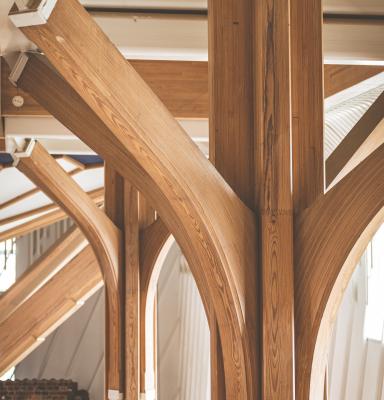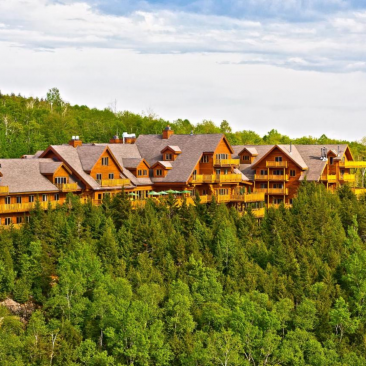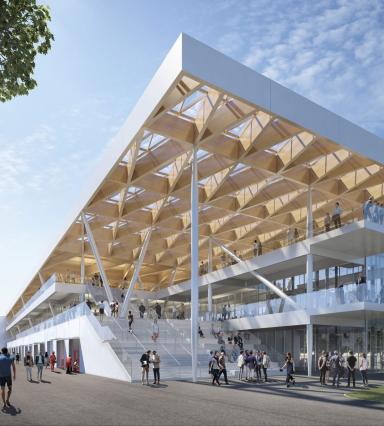
Why Choose FSC-Certified Wood?
Wood is a renewable, recyclable resource that has a significantly lower carbon footprint compared to materials like steel and concrete. Choosing FSC-certified wood ensures that your materials come from responsibly managed forests that meet the highest environmental and social standards.
Here are a few more reasons to choose FSC-certified wood:
-
Lower Carbon Impact
FSC-certified working forests store up to 29% more carbon than conventionally managed forests, helping combat climate change.
A recent study shows that FSC-certified working forests store an average of 29% more carbon than conventionally managed forests across Oregon and Washington and in 2022.
A field study by Ontario Nature validated a large amount of additional carbon stored in FSC-certified forests in Ontario, Canada.https://ecotrust.org/tipping-the-balance-to-more-carbon-storage/
https://ontarionature.org/evaluating-carbon-storage-in-fsc-designated-conservation-lands-blog/
-
Extensive Biodiversity Protection
FSC certification assures the highest requirements for biodiversity protection currently available for commercial forestry.
Forest managers must protect rare, threatened, or endangered species and critical ecosystem services. -
Upholding Indigenous Peoples' Rights
FSC requires forest owners and managers to uphold the rights of land ownership, use of land, and access to resources, and ensure Free, Prior, and Informed Consent on all forest-related decisions.
FSC’s Indigenous Foundation also actively prioritizes the rights of Indigenous Peoples and promotes Indigenous-led actions and solutions.
-
Preventing Deforestation and Forest Degradation
FSC is an effective tool for implementing strict practices which are proven to be a solution against deforestation and degradation.
-
Better Consumer Confidence
80% of consumers who recognize FSC trust brands that offer FSC-certified products (Ipsos, 2023).
-
Supply Chain Transparency
FSC's Chain of Custody certification ensures traceability from forest to final product.

Wood Products Available with FSC Certification
FSC-certified wood is available in a variety of applications, from mass timber to flooring, cabinetry, and decorative finishes. Whether you're working on residential, commercial, or infrastructure projects, FSC wood provides a responsible alternative without compromising quality or durability. Examples include:
- Structural Materials: Cross-Laminated Timber (CLT), Glulam, Dimensional Lumber
- Finishing Materials: Flooring, Panels, Cabinetry, Veneers
- Outdoor Applications: Decking, Siding, Fencing
Need help finding FSC-certified materials? Email us at info@ca.fsc.org.
Interested in Getting Your Wood Product Certified?
If your company is involved in the transformation, processing, manufacturing or distribution of a forest-based product and you want to get certified so you can apply an FSC label to your products and/or sell them with an FSC claim, please reach out here. We can help.
This includes, but it not limited to:
- Mass Timber manufacturers
- Furniture manufacturers
- Lumber manufacturers
- Pre-fabricated housing
- Plywood
- Custom Millwork
- Flooring
- Cabinetry

For Architects, Developers and Contractors
By integrating FSC-certified wood, building projects can not only enhance their environmental credentials but also align with the broader sustainability goals across these certifications, reinforcing a commitment to sustainability and responsible resource management. Here are some sustainable synergies:
Environmental Performance
FSC certification directly supports environmental credits across LEED, WELL, BOMA BEST, One Planet Living, and GRESB, as it ensures sustainable forestry practices and promotes the use of low-carbon materials.
Material Transparency and Sourcing
LEED, WELL, and Fitwel recognize FSC-certified wood for its transparency and responsible sourcing, enhancing sustainable construction practices.
Human Health & Well-Being
FSC mass timber contributes to healthy indoor environments in WELL and Fitwel by reducing harmful environmental impacts.
ESG Goals
GRESB’s focus on ESG factors is complemented by FSC’s commitment to social and environmental responsibility, improving ESG scores in real estate portfolios.
Join us in building a better tomorrow — where every creation is not just a masterpiece, but a testament to responsible choices. Choose FSC-certified wood products and be a part of the change our planet deserves.
FSC & LEED
The Leadership in Energy and Environmental Design (LEED) is a green building rating system with a voluntary framework that sets guidelines for sustainable design and construction in commercial and residential buildings.
The Certified Wood Credit in LEED has arguably been the most important driver of forest conservation and sustainability in modern history. It has contributed to tens of millions of acres of improved forest management and has protected both forests and their workers in their community.
While there are multiple credits you can earn, the key credit in LEED v4 you can receive utilizing FSC-certified wood is known as “Building product disclosure and optimization - sourcing of raw materials.” To receive the credit, a project must use products that meet one of several responsible sourcing criteria, including FSC, for at least 20% by cost of the total value of permanently installed building products.
FSC & The Living Building Challenge
The Living Building Challenge requires all wood used in projects to be FSC certified, from salvaged sources, or intentionally harvested from onsite timber for the purpose of clearing the site.
Learn more on the Living Building Challenge.

Continuing Education Course – Sustainable Mass Timber Adoption
FSC is hosting a limited number of one-hour, live or online, lunch & learn style presentations – including Q&A - for architectural firms and developers. This session qualifies for a one-hour continuing education credit for architects.
To learn more or to schedule your own presentation, please email us here.
You can expect to learn:
- Key factors behind mass timber's growth, including technical advancements, manufacturing and policy limitations, sustainability drivers, and industry best practices for resilient adoption.
- The tools, strategies, and resources that building professionals can use to contribute to market transformation and sustainable forest management practices.
- The role of FSC-certified materials in promoting responsible forestry and how they align with standards like LEED, WELL and more.
- How to procure and document these materials to earn FSC credits.
By the end of this course, participants will be equipped with strategies to support the resilient, sustainable adoption of mass timber.

Project Certification
FSC has a tailor-made certification called project certification for companies and organizations involved in construction, building or renovation projects using wooden building materials.
It can be builders, consultants, home and module manufacturers, craftsmen, contractors, construction companies and other construction companies.
Project certification is an easy and financially manageable way to document and communicate that a project uses wood from responsibly managed forests and other controlled sources.


